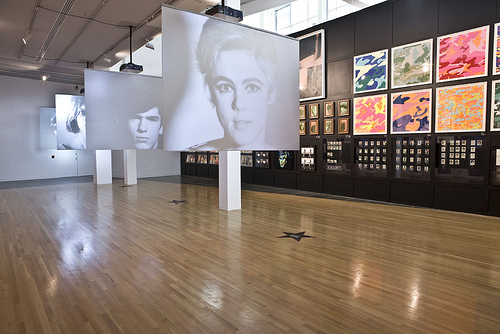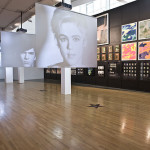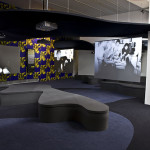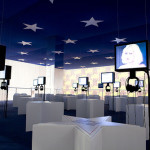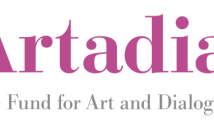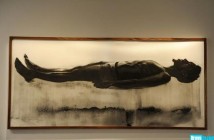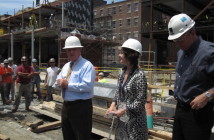ANDY WARHOL: OTHER VOICES, OTHER ROOMS @ THE WEXNER CENTER FOR THE ARTS
I have never been a huge fan of Andy Warhol (and this is my second Warhol exhibition review - go figure). His presence as a culture force is inescapable (especially for those of us who grew up in the eighties). I managed to navigate art school with a minimum of exposure. I can’t explain why exactly, but I felt that the immensity of his effect on culture made me less inclined to examine his work. It was overwhelming and honestly it was far easier to dismiss it than it was to engage with it. There was simply too much. However, with last year marking what would have been Warhol’s eightieth birthday, there was an examination (or a revisiting) of his work and legacy. As I noted in my review of the “Pop Politics” exhibition at the Currier Museum of Art many institutions paid tribute to Warhol by investigating specific aspects of his work. While visiting family over the holidays I had the opportunity to check out one of the largest and most complicated exhibitions on Warhol, “Other Voices, Other Rooms” at the Wexner Center for the Arts at the Ohio State University in Columbus, Ohio.
The show is immense. It is spread out over four large galleries, two smaller spaces and is comprised of 706 items: 31 films, 1 installation, 40 screen tests, 6 videos, 42 TV-episodes, 23 drawings, 42 paintings, 21 boxes, 33 photobooth photographs, 100 Polaroids, 12 contacts sheets, 6 sewn photographs, 1 time capsule, 21 royaltone photos, 4 magazines, 1 silver book, 3 newspapers, 2 postcards, 2 photo-documents, 26 LP-sleeves, 50 screen prints, 100 interview magazines, 1 shopping bag, 1 T-shirt, 1 Plexiglas object, 1 lithograph, 3 portfolios, 12 artists books, 13 audio tapes, 19 factory diaries, 5 wallpapers, 81 photographs, and 2 photo albums. If I had thought Warhol was overwhelming before, after the show I was positively flabbergasted.
The exhibition originated at the Stedelijk Museum Amsterdam and the Moderna Museet in Stockholm. These two institutions are re-visiting Warhol after forty years. In 1968 both played host to Warhol’s first European retrospectives. Independent curator Eva Meyer-Hermann created the exhibition to foreground Warhol’s film and video work. She has also cleverly included many items that place his time-based work in context. The result is a show that is far-reaching, comprehensive and eye opening.
The exhibition is divided into three sections: Cosmos, Filmscape, and TV-Scape. They are not distinctly divided amongst the galleries. Cosmos and Filmscape share the spaces. Filmscapes are clearly the films being played and Cosmos represents all the other items that supplement the show: the paintings, the drawings, the boxes, the album covers, etc. The film and video work are centered within the galleries drawing the eye directly to the screens. The spaces and walls around the screens are covered by drawings, paintings and small ephemera displaying the breadth of Warhol’s production. From a printed shopping bag to a t-shirt to a grouping of the famous soup-can paintings there is almost too much to see.
As you enter the exhibition four screens hang across the gallery, each containing a series of Warhol’s Screen Tests. Each four-minute film hangs silently drawing the eye to the faces of Salvador Dali, Jane Holzer, John Cale, Lou Reed and many others (10 each screen). They stare out at you like icons, unknowable and remote. The first gallery also contains Warhol’s audiotapes. Individual listening posts are carved into the far wall of the gallery allowing one to sit and listen to the voices of Warhol, Edie Sedgwick (telling Warhol how to make a film), Leni Riefenstahl, John Kennedy Jr, and even Warhol’s mother singing. While at times hard to hear (due, I’m sure, to the diminishing quality of the tapes – these have been transferred to DVD for the exhibition) they are remarkable for their ability to contextualise the other work in a way that the 2-D items cannot. By placing them alongside the silent screen tests one can get a glimpse into a moment in time. Warhol’s voice resonates and projects from the past (the tapes run from the 1950s up to 1976). It is a remarkable way to start the exhibition.
There is a long corridor that leads up to the other galleries. Alongside one wall are a series of small flat screen monitors running a series of videos titled “Factory Diaries” and they are also part of the “Cosmos” section. Nineteen in all, they run the gamut from simply documenting the installation of Warhol’s Whitney retrospective in 1971 to my personal favourite “Movie Stars Houses’” from 1972. In this video, shot in black and white reel-to-reel videotape, Warhol and a car full of friends, tour through Beverly Hills shooting footage and gossiping about the various movie stars whose homes they pass by. It is a fascinating look at Warhol’s obsession with celebrity and stardom. You can here the awe in his voice as they stop in front of Lucille Ball or Jack Benny’s home. Here is Warhol the fan getting a glimpse from afar. I found it to be incredibly revealing. For a man who would become the center of his own celebrity circle here is a moment where he displays his own desires and is simply a groupie like the rest of us. This is in stark contrast to a video further up the wall where Warhol and Liza Minnelli hang out in the Factory discussing art, fashion and mutual friends from 1982. Here he has entered that rarified space that a decade earlier so fascinated him.
Warhol’s films, the films of “Filmscape,” fill the majority of the other two large gallery spaces. The films are projected throughout the space in a manner that doesn’t overwhelm or cause one film to intrude on another. The installation is sophisticated and well done. There are a couple of moments when audio from one drifts across another but these are few and far between. Four films stood out for me. Henry Geldzahler from 1964 consists of a static camera focused upon the famed curator of the Metropolitan Museum of Art (Geldzahler was curator of contemporary art and organized the landmark exhibition “New York Painting and Sculpture: 1940-1970”). He sits upright staring confrontationally at the camera smoking a cigar. Yet over the course of the 99-minute film he slowly loses his power. The immobile eye of the camera begins to take over and Geldzahler slowly collapses into the couch, eventually reaching the fetal position. Another film, also from 1964, is Soap Opera. Co-directed by Jerry Benjamin it starred Jane Holzer and Gerald Malanga who acted out small silent plot free situations. These are intercut with actual commercials directed by Lester Persky from the 1950s. The result is an often hilarious juxtaposition of inane meaningless scenes and inane (now) meaningless advertisements for shampoos and broilers.
Two films from 1965 also captured my attention. Both starred Warhol favourite Edie Sedgwick. In Outer and Inner Space, Warhol uses early video technology to examine television and perception. Sedgwick sits in front of a television set playing a pre-recorded image of her face in close-up facing right. She reacts to the image while having a conversation with a person off screen. Over the course of the 33-minute film Sedgwick is increasingly uncomfortable. The static image of her own face distracts and disturbs. It is an intriguing early examination of the “real” and the reproduced image. The other film I quite liked was Kitchen. Starring Sedgwick alongside Roger Trudeau, Rene Ricard, Andy Warhol and others, it takes place in a kitchen. Sedgwick and Trudeau play an unhappy couple having a conversation as people move in and out of the space. It is a wonderfully chaotic jumble of nonsense scenarios.
The final section of the exhibition “TV-Scapes” occupied a smaller gallery at the end of the exhibition. This was one of my favourite sections yet was annoyingly unrewarding. This section consisted of Warhol’s television work. Between 1979 and his death in 1987 Warhol created 42 television broadcasts both on Manhattan Cable TV and MTV. Each of these projects is screened on an individual monitor. You can understand my frustration. Here there was literally too much to see. There were 42 viewing stations across the gallery. At most one could spend a couple minutes at each seat before moving on to the next. Yet frustratingly each video was 30 minutes long. There was a lot to be missed. It was annoying. The Wexner had thankfully listed each program’s contents on the seat so you could quickly scan and see what you were missing or catching. This is a minor complaint but I feel it is indicative of the problems inherent in a show that attempts to show the breadth of Warhol’s film and video work. You simply cannot see it all. They did thankfully include a timer next to each film so that you had an idea when the film would begin again. On the way out I made sure to do another walkthrough and check out the films that were beginning or ending. That was handy.
Overall I left the show excited. I was curious to see Warhol’s films in their entirety. I wanted to see the television programs. I felt that this was finally the Warhol show that permitted me to like his work. It was complex and diverse. The exhibition included work that fleshed Warhol out as a person. There were male nudes, drag queens, and pictures of Warhol with his boyfriends and in drag (work that is often left out due to its controversial nature). Warhol was gay! OMG! Really? It was quite refreshing. And it revealed to me that Warhol was much more than the artist as businessman/celebrity. He was definitely the precursor to the art world/business figures of today: Jeff Koons, Damian Hirst. Yet he was different in that he never claimed criticality. As Mike Kelly notes in his essay from the catalog Warhol “adopts the stance of a dummy, constantly proclaiming the intellectual emptiness of his work and separating himself from the critical community.” He viewed himself as the anti-avant-garde. But this show speaks differently. Warhol was perhaps even more avant-garde than anyone imagined. I walked out of the show in awe of an artist I had long dismissed.
"Andy Warhol: Other Voices, Other Rooms" is on view until February 15th, 2009 at the Wexner Center for the Arts, The Ohio State University, Columbus, Ohio and until January 18th, 2009 at the Hayward, Southbank Center, London.
All images are courtesy of the artist and the Wexner Center for the Arts.
- Andy Warhol, Screen Tests, Installation View, 1964-1966.
- Andy Warhol, Filmscapes, Installation View.
- Andy Warhol, TV-Scapes, Installation View.

